
BCN wishes IM Lawrence Hugh Cooper all the best on his birthday, July 16th in 1970.
1001 Chess Exercises for Club Players : Frank Erwich
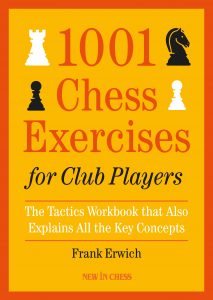
“Tactics is knowing what to do when there is something to do; strategy is knowing what to do when there is nothing to do.” – Savielly Tartakower
Every chess player enjoys (or should !) solving and practising tactics and, let’s be pragmatic, most games at mortal level are decided by executing them if the conditions are right. Creating suitable conditions is, of course, another book or books and I’m confident New in Chess will publish such material in due course.
FIDE Master Frank Erwich is a a professional chess teacher for the Royal Dutch Chess Federations, coach and active player. In 2012 he established a teaching company and, from his own web site :
He works as an editor for New in Chess, he helps with the development of material for chess books and chess apps, he writes about chess (including author of 1001 Chess Exercises for Club Players and the e-book Basic Chess rules for Kids ), he makes online lessons for starting chess players and he is regularly active as a coach during a chess tournament (including during the European Youth Championship in 2014, 2015 and 2016).

So, what is 1001 Chess Exercises for Club Players about ?
The author has identified 1001(!) positions from recent tournament praxis the majority of which are from the last ten years. This, in itself, is a tour de force as many previous tactics books bring a strong sense of déjà vu. He has categorised them into ten groupings viz :
and then follows these with a chapter entitled “Mix” which combines many of the previous themes and of course, a Solutions to each exercise chapter.
As with every recent New in Chess publication high quality paper is used and the printing is clear. The book can easily be laid flat next to the board and does not require weights to prevent it from “self-closing” (a particular bugbear of mine !). Each diagram clearly shows who is to move and the instructional text is typeset in two column format, which, I find, enables the reader to maintain their place easily. Figurine algebraic notation is used throughout and the diagrams are placed adjacent to the relevant text.
You might have noticed that in the list of categories the author has inserted “Trapping a piece” and “Defending” which are welcome (not often discussed) themes among the more familiar ones.
Each chapter kicks-off with a description of the theme in question followed by high quality examples. All jargon and terms are explained in detail making each section self-contained eliminating the need to go elsewhere to cross-reference. Sometimes the author invents his own terminology (such as “away” and “chasing”) in cases where there is a need and all is carefully explained.
Following the instructional text and examples there are, on average 100 test positions given as groups of twelve per page. Each diagram clearly indicates who is to move and underneath most is a hint such as “magnet + double check”. I prefer to hide the hint but some will value these clues. Of course, after say a dozen in one section, one gets a feel for what is expected and this forms part of the training. Each solution provides useful analysis (which has been engine checked) plus contextual information about the source game, players and event.
To give you some idea of the content here is an excerpt from the training section on Elimination of the Defence :
“We conclude this chapter with a spectacular move:
Li Chao, 2746
Nigel Short, 2666
Baku ol 2016 (7) (analysis)
36. Qe6!
This is called a Novotny Interference! The queen is sacrificed on a square where it can be captured in four ways, but whichever black piece makes the capture, it interferes with the range of the other pieces:
36…Rxe6 (and Nxe6) interupts the a2-g8 diagonal and allows 37.Rg8#, while 36…Bxe6 closes off the sixth rank and runs into 37.Bxf6+ Rg7 38.Bxg7#.36…Rg7 prevents immediate mate, but after37.Bxf6 Black will also have to lay down his king before long.”
Here is one of the more challenging exercises :
The hint is “away + material”
and the solution is :
“31…Qe5! 32.Qxe5 32.Qd2 Rxc1+ 33.Qxc1 Qxd4+ -+. 32…Rxc1+ 33.Kf2 Rxe5 34.Nxf6 Kxf6 35. Rxd7 Re7 -+ Jonkman Inza – K. Arnold, Assen ch-NED jr W 2019 (analysis).”
Finally, a detailed glossary in itself provides learning opportunities to improve one’s knowledge.
It was a pleasure to work through the exercises and they provided ideas for my student lessons and coaching. Possibly the most enjoyable section was Chapter 11 entitled “Mix”. This is the best test of what has gone before since there is no declared theme, and, more often than not, no visible hint. You are on your own and you might start a chess timer with each new position to provide motivation and test your speed and accuracy of solution.
In summary this is an excellent book that goes highly recommended. If I hadn’t had it to review then I would have purchased it anyway ! It it much than more than “just another tactics book”.
John Upham, Cove, Hampshire, June 20th 2019

Book Details :
Official web site of New in Chess


BCN remembers Robin Matthews CBE, FBA who died in Cambridge aged 83 on June 19th 2010. Probate (3367272) was granted in Ipswich, Suffolk on September 6th, 2010.
Robert (Robin) Charles Oliver Matthews was born in Edinburgh on Thursday, June 16th 1927. Born on the same day was England cricketer, Tom Graveney.
His English father, Oliver Harwood Matthews became an Edinburgh solicitor and his mother was Ida Matthews (née) Finlay. Robin had a daughter Alison.
He was educated at Edinburgh Academy and then Corpus Christi College, Oxford becoming a Fellow of All Souls College, Oxford. He went on to become a highly successful economist authoring at least twelve publications on the subject.
According to Wikipedia “He was the Drummond Professor of Political Economy at Oxford from 1965 to 1975 and the Professor of Political Economy at Cambridge from 1980 to 1991. He was also the Master of Clare College, Cambridge from 1975 to 1993.”
For a detailed description of this part of his life there is an excellent obituary / biography from the Australian economist, Geoffrey Harcourt.
Brian Stephenson (BCPS) writes : “Probably the UK’s greatest composer of ‘mate in 3’ #ChessProblems . His chapters in the book you note were what got me hooked on chess composition. Nearly all of his output can be viewed at The Meson Database”
Black Correction: Quaternary Play
First Prize, The Observer, 1964
Mate in three
According to David McKittrick in The Independent:
“Outside academia, Matthews was keen on chess, in particular setting problems and publishing two books on what are known as three-mover directmates, in which white is to move and checkmate black in no more than three moves against any defence.
Although this might be thought a particularly narrow point of interest, one enthusiast said of him that his writings “demonstrated a deep knowledge along with the feeling of wonder and curiosity about the subject”.

From The Oxford Companion to Chess by Hooper & Whyld:
“British Composer, International Judge of Chess Compositions (1957), International Master for Chess Compositions (1965), economist, appointed Master of Clare College, Cambridge in 1975. He has specialised in orthodox three movers and is among the world’s leaders in this field.”
Here is an obituary from The Daily Telegraph
and an obituary from The Independent

From The Encyclopedia of Chess by Anne Sunnucks :
International Master of the F.I.D.E. for chess compositions (1965) and International Judge of the F.I.D.E. for Chess Compositions (1957). President of the British Chess Problem Society for 1971 and 1972. Professor of Economics at Oxford University.
Cyclic Overload Doubled
First Prize, British Chess Magazine, 1968
Mate in three
Born on 16th June 1927. Professor Matthews has composed about 200 problems, about 40 of them 1st prize winners, mainly strategic three-movers, He is one of the world’s best three move composers.
Nowotnys
British Chess Magazine, 1967
His best problems give clear-cut expression of complex themes, with proper attention given to key-move and by-play in the best English tradition.
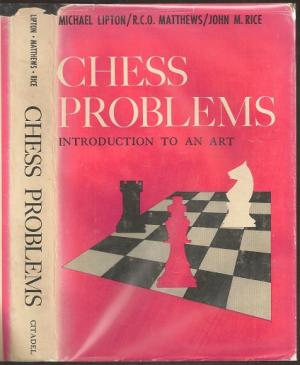
The results are massive rather than elegant, but carefully constructed. Themes he has specialised in include overload White self-weakening and reciprocal change.”
R.C.O. Matthews
British Chess Magazine
1956
White to play and mate in three moves
From Wikipedia :
“Robert (Robin) Charles Oliver Matthews (16 June 1927 – 19 June 2010) was an economist and chess problemist.
Matthews was born in Edinburgh. He was educated at Edinburgh Academy and Corpus Christi College, Oxford, and was a Fellow of All Souls College, Oxford. He was the Drummond Professor of Political Economy at Oxford from 1965 to 1975 and the Professor of Political Economy at Cambridge from 1980 to 1991. He was also the Master of Clare College, Cambridge from 1975 to 1993.”

BCN is delighted to have received recent publications from McFarland Books. They are :
British Chess Literature to 1914 : A Handbook for Historians by Tim Harding
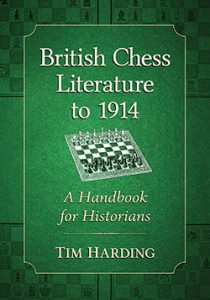
and
Tal, Petrosian, Spassky and Korchnoi : A Chess Multibiography with 207 Games by Andrew Soltis
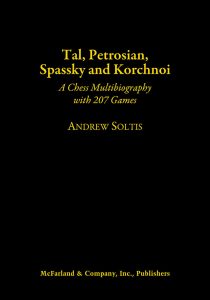

FM Matthew Wadsworth, one of England’s most promising young players, has earned his first Grandmaster norm from his excellent performance in the Four Nations Chess League (4NCL). Matthew, who is eighteen (nineteen in June), has a current FIDE standard play rating of 2413 and is ranked 34th amongst the active players in England (by FIDE rating) earning his FM title in 2016. Matthew has IMs norm under his belt but could leapfrog to Grandmaster status with further norms and by increasing his live rating to 2500. Most likely, however, is that the IM title will be ratified at the next FIDE Congress now that his live rating has topped 2400.
Matthew’s first ECF grade was 66A in 2007 (aged 7) and he played for Maidenhead in local leagues, St. Pirans’s School and then Reading School. Matthew joined 4NCL at an early age and played for AMCA (Andrew Martin Chess Academy) soon rising the ranks to the AMCA first team and he currently represents the Guildford 2 team in Division One of the Four Nations Chess League (4NCL). Matthew’s 4NCL results for the 2018-19 season were :
1. Fodor, Tamas Jr, draw
2. Ashton, Adam G, win
3. Gonda, Laszlo, draw
4. Kulon, Klaudia, win
5. Holland, James P, win
6. Stewart, Ashley, win
7. Ledger, Andrew J, win
8. Plat, Vojtech, loss
9. no game
10. Jackson, James P, win
11. no game
giving a performance of 7/9
One of the undoubted highlights of Matthews chess year was has draw with Oxford domiciled GM Hou Yifan, three times Women’s World Champion from China during the annual Varsity match, Matthew representing Cambridge.
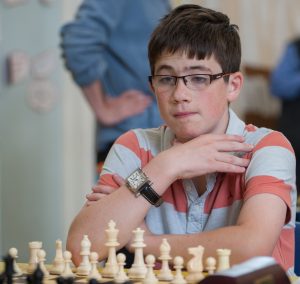
Chess Opening Traps for Kids : Graham Burgess
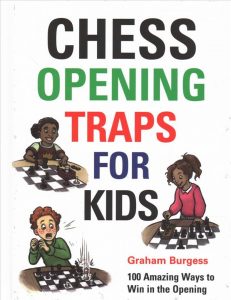
FIDE Master Graham Burgess needs no introduction to readers of English language chess books ! Minnesota, USA based, Graham has authored more than twenty five books and edited at least 250 and is editorial director of Gambit Publications Ltd. In 1994 Graham set a world record for marathon blitz playing and has been champion of the Danish region of Funen !

Readers may remember “101 Chess Opening Surprises” published in 1998, also by Gambit Publications, was well received and added to GKBs reputation for originality, accuracy and encyclopedic knowledge of openings.
Chess Opening Traps for Kids is the fifth in a series of “for Kids” books and is robustly (!) hardbound in a convenient size such that weights are not need to keep it propped open (unlike some A5 paperbacks) meaning studying with this book is more convenient than with many books. The layout and printing is clear (as you would expect with Gambit) with numerous diagrams at key moments in each, relatively short, game. In essence, players under 18 (for whom this book is intended) will find it easy to dip in out of and it can be used without a board (although BCN would always recommend following each game on a “proper” board).
As you would expect with Gambit, the notation is English short form algebraic using figurines for pieces. One slight criticism is that the diagrams do not have “whose move it is” indicator. We know that many readers like to see this on all diagrams. However, each diagram does have coordinates; welcome for the junior readership.
Graham has identified and described 100 unique themes (usually tactical) that lead to relatively short wins out of the opening, many of which could be termed “miniatures”. An example theme is “Drag the King Out with Nxf7” : “Sometimes players leave f7 so weak that a knight sacrifice on that square wins by force. The signs to look out for are a queen that can invade on e6 and other pieces ready to support the raid.” Under this theme the author presents three examples (typical for each theme) from different openings plus supporting analysis and explanation.
A range of openings are demonstrated that yield a similar trap. For example, The Siberian Trap is shown from the usual perspective of the Sicilian Defence and the Queen’s Gambit Accepted. In the main, the author does not get bogged down giving details of who were the players of the games and when and where they were played but does in a few cases where the players are especially well known.
The author’s explanations and language are clear, concise and presented with a friendly and engaging style. There are numerous cross references to other themes when an idea uses a previously mentioned one. All of this contributes to the learning experience and the pattern recognition aspects of chess that are especially important for young players in their formative years. Thankfully, there is no recourse to engine evaluations and the emphasis is to use one’s personal brain engine in making an assessment. (One of our bugbears as chess teachers and coaches is juniors increasingly relying on engine assessments rather than their own brains).
Having worked through the 100 themes the student is presented with 48 exercises (with solutions) that test the students understanding (not memory) of what they hopefully have learnt.
Finally there are useful tips on further improvement and how to make progress.
In summary, this is an excellent book with much original material presented in a clear and friendly way and therefore to be recommended.
One negative comment we would make concerns the cover. “Never judge a book by its cover” we are told and you might look at this book cover and think it was suitable for say primary aged children. I would say not but I would suggest it suitable from secondary aged children. I would say strong juniors from 12 upwards would read this book and enjoy it.
Apart from the “move indicator” we would like to see an index of openings from which the theme examples were obtained.
The title and cover might, perhaps, put off the adult club player market. However, the content is totally suitable for adult club players upto say 180 ECF or 2000 Elo.
As a postscript, we have reviewed the follow-up workbook here
John Upham, Cove, Hampshire, April 5th 2019

Book Details :
Official web site of Gambit Publications Ltd.
